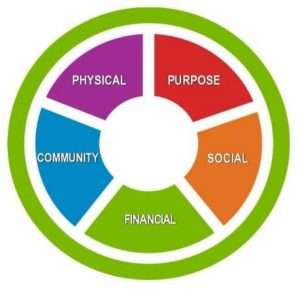11 Oct Wellness Program in a Box
Keeping employees healthy and doing the right things is hard. Really hard. This is especially true when looking at the entire spectrum of well-being, which addresses an individual’s comprehensive health status. Elements of well-being include:
- Purpose/career: liking what you do each day and being motivated to achieve your goals.
- Social: having supportive relationships and love in your life.
- Financial: managing your economic life to reduce stress and increase security.
- Community: liking where you live, feeling safe, and having pride in your community.
- And of course, Physical: having good health and enough energy to get things done daily.

Addressing mental health, as we’ve written about before, is also a crucial part of the pie, but it is assumed to be covered in this model if the other components are being met.
According to a recent JAMA study that we highlighted in a previous blog post, the return-on-investment for traditional wellness programs has been tough to prove, and traditional wellness program offerings are showing less-than-stellar results. So what can you as an employer due to bolster your employees’ well-being without breaking the bank?
One tool to rule them all
What if there was ONE tool that was able to affect ALL components of well-being? I’m here to argue there is. The bicycle, as simple as it is, is still one of the most effective and efficient tools we humans have. While it is great as a recreational tool, the power of the bicycle is truly unleashed when used in place of a car, as in “active transportation.” Let’s break it down by well-being component:
Physical health: While the number of calories burned is dependent on the person’s size, speed, distance, and other factors, the average person will burn between 450-750 calories per hour. You can enter in your specific numbers if you’re interested to see how much you’d burn. While you’re burning all those calories, commuting by bike might reduce your mental health days by over 20 percent.
Financial health: Driving a car is expensive. The IRS mileage reimbursement rate is currently $.545 per mile, which is based on the realistic addition of costs. This accounts not just for gas, but also “wear and tear” on your vehicle that will eventually require maintenance (i.e, transmission, motor, tires, etc). Assuming an 8-mile commute (1-way), which is still manageable, that saves the bicycle commuter more than $8 EVERY DAY they ride. Even if you start with commuting just two days per week, that’s $65 per month in savings.
Social health: The cycling community, in Wichita especially, is very tight-knit and welcoming. There are cycling groups for just about any demographic. The Wichita Geezers is a great group for older riders, WomenBikeICT is perfect for women of all ages who want to ride with other women, Sunday Dose of Vitamin G for those who prefer gravel biking, Sunday Slow Rolls for those who like a slower pace, and many others I’m not mentioning! Bike Walk Wichita is also a fantastic place for cyclists to meet with other like-minded people. Whichever group you choose, you will be able to spend time with others while engaging in a fun and healthy activity!
Community health: As you begin biking through Wichita, and seeing the city at 10-15 mph instead of 40+ mph in a car, you really begin to appreciate all our wonderful city has to offer. According to Strong Towns philosophy, this is also good for the economic viability of a city, as residents are more likely to stop at a store if they are on a bike vs a car. All of this is more likely to make a person truly proud of where they call home. I ride my bike to work almost every day and I can honestly say it’s one of the best parts of my day.
Purpose/career: By biking to work, you automatically feel more invigorated and motivated to take on the day, because you’ve already accomplished something just by getting to work. In turn, this has the potential to increase your employee’s work satisfaction and purpose.
What you can do
So this is all great, but how do you harness these benefits for your employees? This is where strategic wellness programming come into play. Instead of offering incentives for things like completing a biometric screening or attending a nutrition class, you might consider shifting that money to pay for things such as:
- Providing bike amenities such as a bike rack or on-site shower.
- Stipends for employees to buy or repair their bicycle.
- Incentives for each day an employee opts to bike to work rather than drive. This could be a per-day incentive payment, or a per-mile incentive.
By making it easier for your employees to bike to work, you are ensuring they are receiving all the benefits stated above, with very little money needed from you as the employer. And what money does get put into active transportation is well-spent. An analysis of Portland, Oregon, where roughly six percent of the population bikes to work, found that the return on investment for cycling-related transportation was roughly 3:1 when accounting for direct healthcare costs. When the value of prolonging human lives was added the ROI rose to almost 50:1 (a single quality-adjusted life year is considered to be worth roughly $100,000 by actuaries).
If you or your employees are concerned about certain aspects of cycling, such as how to repair and maintain a bike, how to ride a bike for those who have ridden in a while, or how to safely commute on the roads, organizations like Bike Walk Wichita offer education and assistance to anyone interested (often times free, or for a very low cost). Making the decision to begin riding is the hardest part!


